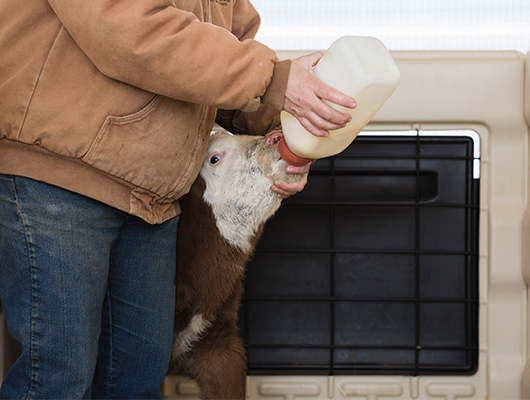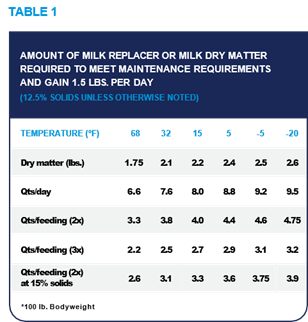By Megan Wildman, Purina Calf & Heifer Specialist

When choosing the right milk replacer for your calves, start with your goals for the calves. Do you want your calves to get the most growth possible during the most efficient stage of life? Are you trying to boost their immunity because you’re fighting a disease challenge? Are you trying to help them gain through extreme heat or extreme cold?
There’s lots to consider when choosing the best calf milk replacer for your herd. To make the decision easier, we’ve compiled a list of questions and considerations you need to know.
What’s the outside temperature?
Young calves have a thermal neutral zone between 60-75°F. Calves may undergo cold stress at temperatures below their thermoneutral zone. Specifically, calves less than three weeks of age can experience cold stress at 60°F, and calves older than three weeks of age can experience cold stress at 42°F. If calves don’t get enough energy in their diet during cold stress conditions, they will use their body fat as an energy source. Energy will be diverted from supporting growth and immune function to maintaining core body temperature. As a result, calves may experience weight loss and impaired immune function and you’ll need to increase the amount of replacer to ensure calves achieve their average daily gain of 1.5lbs.


Will you need to increase feeding rates in the winter?
Increase the quantity of milk or milk replacer to meet the increased caloric needs of cold stressed calves. Adding a third feeding (preferably late at night) is a great way to deliver added nutrition. If already feeding calves three times a day, increase the volume at each feeding. Keep the solids concentration the same and bump up the total volume of the solution. Feed a full potential diet of at least 2.5 pounds of milk solids from 8-12 quarts of milk or milk replacer per day.
It’s important to have the correct protein to fat balance when increasing the quantity of milk replacer fed. The traditional method of feeding approximately 2 quarts of 20:20 milk or milk replacer twice a day falls far short of the energy requirements needed to support both maintenance and growth of young calves, especially in colder temperatures. To increase energy levels, look for a milk replacer with at least 26% protein and 20% fat. Milk replacers with more than 20% fat may decrease growth and hinder starter intake, especially when temperatures moderate.

Are you providing the right energy sources?
The energy in milk or milk replacer is predominately derived from two sources – carbohydrates and fat. The predominant source of carbohydrates in milk or milk replacer is lactose. Milk replacer is generally comprised of about 35-45% lactose. Carbohydrates are rapidly digested and provide nearly instant energy, while fat is stored for longer-term use and is a reserve energy source mobilized as needed.
The source of fat in milk replacer is an important and often-overlooked consideration. Milk fat, due to its high value in the human nutrition market, is not typically added to calf milk replacers, leaving alternative sources to supply fat such as lard, choice white grease or tallow.
The fatty acids that make up fat are classified as short-chain, medium-chain, and long-chain fatty acids. The length of the chain depends on the number of carbon atoms in the structure of each fatty acid. Medium-chain fatty acids are highly digestible, as they are absorbed directly from the small intestine to the liver, where they are converted to available energy.
Certain polyunsaturated fatty acids (omega-3s) modulate the inflammatory response by the calf’s immune system, allowing the calf to recover more quickly from an immune challenge. The key to optimizing fatty acids in milk replacer is to mimic levels present in cow’s milk. While most cow’s milk fat is made up of long-chain fatty acids, it also contains 8-12% medium-chain fatty acids.
Look for these ingredients and understand what replacements that may need to be made in each replacer to ensure your calf has enough energy from healthy sources.
Are you supporting your calves’ microbiome?
Calves are born with a sterile gastrointestinal (GI) tract – essentially a blank slate ready to be populated with microorganisms. Establishing a healthy, balanced gut environment as soon as possible is critical to the health and development of pre-weaned calves.
The gut microbiome (or gut microorganism population) plays an important role in calf health, as 70% of the calf’s immune system resides in the gut.
The gut microbiome plays an important role in disease prevention and maintaining calf health, especially during times of stress when there is higher susceptibility to disease. Feeding probiotics pre-weaning can help establish a healthy microbiome and support immune strength. Research showed probiotics can help optimize bacterial diversity in the gut that may help address health challenges.
A healthy gut microbiome helps:
- Promote and maintain calf immune system health.
- Prime the immune system to stay alert and prepared for disease challenges.
- Stimulate mucous layer production on the intestinal wall to provide a barrier against pathogens.
- Enhance the gut immune response to invading pathogens.
- Saturate the colonization sites on the intestinal tissue.
- Break down nutrients for optimal absorption.
Consider the probiotics and other elements that support a calf’s microbiome when identifying the right replacer for your needs.
Do you provide fresh water?
Water is equally as important in cold temperatures as it is in the summer heat. Like hot summer days, dry winter air can also dehydrate calves. Providing adequate water supply helps improve hydration and supports growth by optimizing calf starter feed intake.
Also, remember the effects water has on milk replacer when mixing. The replacer solution should not drop below their body temperature so pay attention to your milk’s temperature just as much as you do your calf’s needs for hydration.
Offer warm water to calves immediately after each milk replacer feeding and let them drink as much as they want. Make sure water is 100-105°F to avoid lowering calf body temperatures. For those feeding milk or milk replacer two times a day, add a third water feeding mid-day to help optimize starter intake.
Considering all of these factors will help you determine the best milk replacer for your calf. At Calf-Tel, we’re here to help you raise healthy calves by supporting your needs and answering your questions. That’s how we create the most durable, labor-efficient, and cost-effective solutions available. And that’s how you raise healthier, more productive calves.
About the Author
Megan Wildman is a calf and heifer specialist with Purina Animal Nutrition in New York. She joined Purina after working as the Cornell University Research Center herd assistant. While at Cornell, she earned a bachelor’s degree in animal science. She’s a sixth-generation dairy farmer and wants the best for you and your calves. You can learn more about Purina calf products at https://www.purinamills.com/ 1 Corbett, R. Prime the pump. Bovine Veterinarian. April 22, 2019 2 Direct-Fed Microbials (Probiotics) in Calf Diets. Bovine Alliance on Management and Nutrition. 2011 Download English PDF Download Spanish PDF Courtesy of our dealer – CRI REPRODUCCIÓN ANIMAL MÉXICO SA DE CV.
Courtesy of our dealer – CRI REPRODUCCIÓN ANIMAL MÉXICO SA DE CV.
